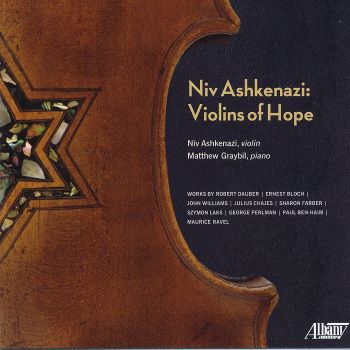AN ALBUM WHICH DOES INDEED OFFER HOPE
81 years ago, Moshe Weinstein and his wife, Golda, moved to Tel Aviv and opened a violin shop. They had both graduated from the Vilna conservatory, Moshe as a violinist and Golda as a pianist, and followed the large Jewish emigration from Europe to Palestine.
In postwar Europe, survivors of the Holocaust ’” remnants of the continent’s once rich and thriving Jewish communities ’” poured out of liberated concentration camps, work camps, and displaced-persons camps. Some made their way to British Mandate Palestine and what would soon become the new, modern Jewish State of Israel. Many made their way to our shores in the United States, Canada, and Latin America. Countless more remained locked behind the Iron Curtain as the Cold War settled across the globe.
Moshe and Golda Weinstein
Amid the human destruction and displacement, the treasures of the Jewish people also were displaced. The sacred ’” Torah scrolls, prayer shawls, and other ritual items ’” but in even greater numbers, the artistic and musical treasures sacred to Jewish culture throughout Europe. The Nazis burned, smashed, looted, and confiscated the possessions of millions. But some precious pieces remained. Many musical instruments survived when their owners did not. Many more were lost or abandoned as their owners escaped the war. And when the Allies liberated Europe in 1945, hope remained.
For Moshe and Golda’s son, Amnon Weinstein, that hope manifested in the thin wooden bodies of violins, violas, and cellos rescued from the Holocaust. Amnon and his son, Avshalom, created Violins of Hope to celebrate the triumph of the human spirit. Using their private collection of over 60 violins, violas, and cellos all restored since the end of World War II, the Weinsteins continue to tell the story of the instruments’ previous owners, each with their own personal stories from the Holocaust.
Niv Ashkenazi
A number of concerts were scheduled this year in my hometown, Los Angeles, but were all cancelled due to COVID-19. Then I received a CD of violin solos by rising star Niv Ashkenazi, Not only is this the first solo album to be recorded on one of these saved instruments, but many of the composers were directly affected by the Holocaust, either by fleeing or, sadly, death. Ashkenazi, who is the only violinist in the world to hold an instrument from the Violins of Hope collection on a long-term loan, plays on a violin which was built between 1900-1929 in eastern Europe or Germany.
I’ve seen Ashkenazi play with the LA Phil (he’s the first artist-in-residence at the gorgeous Soraya in L.A.), so I can attest to his musicianship. I’ve cut-and-paste much of this information here because knowing this much before listening made it feel like the enterprise was gonna be gimmicky, and I had no intentions of writing about it.
But upon hearing this collection — including Williams’ oft-played theme from Schindler’s List — I must tell you that Niv Ashkenazi is the real thing. An emotional connection to both his instrument and the music makes the sound exquisite, earnest and fervent. Knowing the context of the recording also makes it heart-tugging. The gracious and emotive piano accompaniment is by Matthew Graybil. A winner!
Matthew Graybil
Niv Ashkenazi: Violins of Hope
Niv Ashkenazi, violin
Matthew Graybil. piano
14 tracks | 58:37
available on iTunes and Amazon
Serenade Robert Dauber
Nigun Ernest Bloch
Theme from Schindler’s List John Williams
The Chassid Julius Chajes
Bestemming: Triumph Sharon Farber
with Sharon Farber (piano); Tony Campisi (narrator)
Trois pièces de concert Szymon Laks
Dance of the Rebbitzen George Perlman
Berceuse sfaradite Paul Ben-Haim
Kaddisch Maurice Ravel
Three Songs Without Words Paul Ben-Haim

